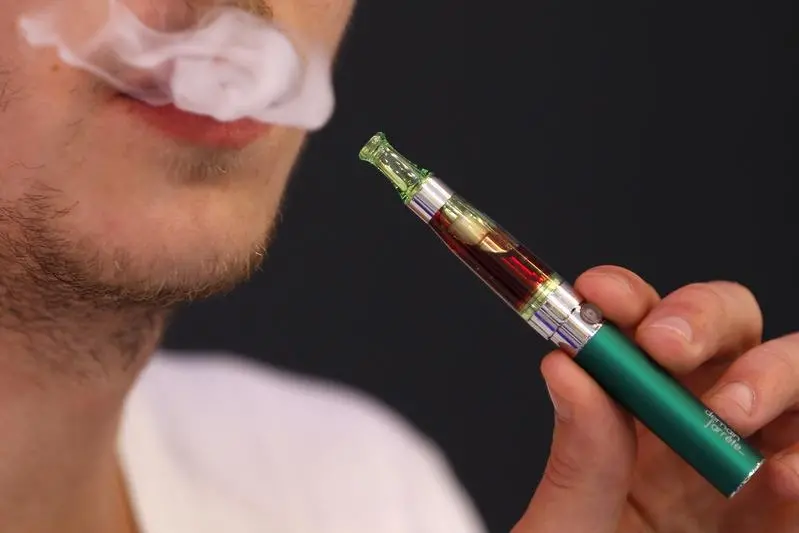PHOTO
26 October 2016
By Kathryn Doyle
(Reuters Health) - Most U.S. middle and high schoolers believe e-cigarettes are less harmful and less addictive than traditional cigarettes, but believe other products like smokeless tobacco and cigars fall somewhere in between, according to national surveys.
They're not necessarily wrong, but that comes with caveats, experts say.
"E-cigarette safety continues to be debated by public health experts," said lead author Dr. Stephen M. Amrock of Oregon Health and Science University in Portland.
"U.S. youth may not be wrong that e-cigarettes are less harmful than cigarettes, but such a view captures only half the story," Amrock told Reuters Health by email. "Less harmful does not equate with no harm."
Researchers used data from the 2012 and 2014 National Health and Nutrition Examination Surveys of kids in grades 6 to 12. The surveys included questions about various tobacco products, asking participants' perceptions of their harm and addictiveness.
In 2014, almost three quarters said e-cigarettes are less harmful than cigarettes, while only 26 percent said the same for cigars and 20 percent said the same for smokeless tobacco. Regarding addictiveness, almost half said e-cigarettes are less addictive than cigarettes, compared to 14 percent for smokeless tobacco and 31.5 percent for cigars.
Users rated each product less harmful and addictive than did nonusers. Boys, Hispanic students and those living with a user of one of the products also were more likely to rate them less harmful or addictive.
Between 2012 and 2014, more kids thought they were able to assess the relative harm of e-cigarettes and increasingly believed them to be less harmful than cigarettes, according to the results in Pediatrics.
"Even over the past few years, our research captures a shift in children's thinking about e-cigarettes," Amrock said. "This comes at a time that e-cigarettes are now the most commonly used tobacco product among U.S. youth," he added.
"Children who believe e-cigarettes are safer are more likely to use e-cigarettes," he noted.
The FDA recently began to regulate e-cigarettes as tobacco but those regulations have only partly taken hold, Amrock said.
"Yet concern exists that these products are making smoking seem 'cool' again -that they are being re-normalized," Amrock said. "Children and parents need to understand that these products contain nicotine and are potentially harmful, both now and down the line."
"E-cigarettes are the low end of a continuum of risk of tobacco products, below snus, cigarettes and cigars," said Thomas J. Glynn, consulting professor at the Stanford Prevention Research Center in California who was not part of the new study. "Our youth have figured this out, but this does not mean e-cigarettes are safe or something any adolescents should be using."
Kids are good at understanding the relative risk of cigarettes and e-cigarettes but may downplay the addictiveness of the latter, Glynn told Reuters Health.
E-cigarettes, or vapes, can also vary widely in what they actually contain, he said.
"Some are very high in formaldehyde and others are not," he said. "When public health agencies do their messaging they need to acknowledge, just because they are less harmful doesn't mean they are not harmful."
By Kathryn Doyle
(Reuters Health) - Most U.S. middle and high schoolers believe e-cigarettes are less harmful and less addictive than traditional cigarettes, but believe other products like smokeless tobacco and cigars fall somewhere in between, according to national surveys.
They're not necessarily wrong, but that comes with caveats, experts say.
"E-cigarette safety continues to be debated by public health experts," said lead author Dr. Stephen M. Amrock of Oregon Health and Science University in Portland.
"U.S. youth may not be wrong that e-cigarettes are less harmful than cigarettes, but such a view captures only half the story," Amrock told Reuters Health by email. "Less harmful does not equate with no harm."
Researchers used data from the 2012 and 2014 National Health and Nutrition Examination Surveys of kids in grades 6 to 12. The surveys included questions about various tobacco products, asking participants' perceptions of their harm and addictiveness.
In 2014, almost three quarters said e-cigarettes are less harmful than cigarettes, while only 26 percent said the same for cigars and 20 percent said the same for smokeless tobacco. Regarding addictiveness, almost half said e-cigarettes are less addictive than cigarettes, compared to 14 percent for smokeless tobacco and 31.5 percent for cigars.
Users rated each product less harmful and addictive than did nonusers. Boys, Hispanic students and those living with a user of one of the products also were more likely to rate them less harmful or addictive.
Between 2012 and 2014, more kids thought they were able to assess the relative harm of e-cigarettes and increasingly believed them to be less harmful than cigarettes, according to the results in Pediatrics.
"Even over the past few years, our research captures a shift in children's thinking about e-cigarettes," Amrock said. "This comes at a time that e-cigarettes are now the most commonly used tobacco product among U.S. youth," he added.
"Children who believe e-cigarettes are safer are more likely to use e-cigarettes," he noted.
The FDA recently began to regulate e-cigarettes as tobacco but those regulations have only partly taken hold, Amrock said.
"Yet concern exists that these products are making smoking seem 'cool' again -that they are being re-normalized," Amrock said. "Children and parents need to understand that these products contain nicotine and are potentially harmful, both now and down the line."
"E-cigarettes are the low end of a continuum of risk of tobacco products, below snus, cigarettes and cigars," said Thomas J. Glynn, consulting professor at the Stanford Prevention Research Center in California who was not part of the new study. "Our youth have figured this out, but this does not mean e-cigarettes are safe or something any adolescents should be using."
Kids are good at understanding the relative risk of cigarettes and e-cigarettes but may downplay the addictiveness of the latter, Glynn told Reuters Health.
E-cigarettes, or vapes, can also vary widely in what they actually contain, he said.
"Some are very high in formaldehyde and others are not," he said. "When public health agencies do their messaging they need to acknowledge, just because they are less harmful doesn't mean they are not harmful."












